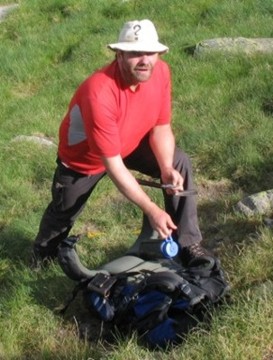
Teaching
Publications
Myself

Nothing beats field work in the Pyrenees on a sunny day!
Trail-sharing: Bear, wolf and man, in that order, along the Slims River, Kluane National Park, Yukon Territory.
Diplom-Geologe, Ph.D.
Wissenschaftlicher Assistent
Arbeitsgruppe Allgemeine Geologie
Institut für Geologische Wissenschaften |
Raum 3-1-28 |

|
Curriculum vitae Teaching Publications Myself |
 |
|
Nothing beats field work in the Pyrenees on a sunny day! |
Trail-sharing: Bear, wolf and man, in that order, along the Slims River, Kluane National Park, Yukon Territory. |
I am a structural and metamorphic geologist with special interest in the interaction of metamorphism and ductile deformation. My research commonly involves aspects and problems of regional geology in metamorphic core zones of mountain belts, such as the North American Cordillera and the Pyrenees.
Research methodology:
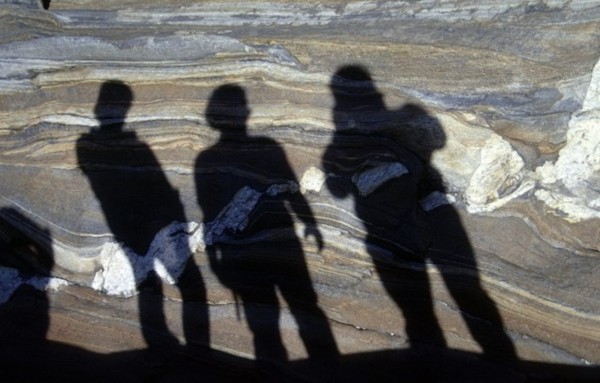
Structural and metamorphic domes, also called gneiss domes, are common structural features in core zones of orogenic belts. A core of granite, orthogneiss or migmatite is mantled by high-grade metamorphic rocks. Domes are commonly elliptical in shape with their length axes aligned parallel to the orogenic trend. This suggests that dome developement was controlled by crustal flow processes that shaped the orogen. Situated in core zones of orogens, the tectonometamorphic evolution of gneiss domes reflect major phases of the earlier history of an orogen. Tectonic models explaining gneiss dome evolution can grouped into four categories:
A good place to study gneiss domes is the Variscan core of the Pyrenees, the so-called Axial Zone. The Pyrenean mountain chain itself is the result of a younger orogeny, the Alpine orogeny. The Axial zone consists of three major lithotectonic units:
The asymmetric geometry of the Pyrenees exposes deeper structural levels at the eastern end. Gneiss domes of the eastern central and eastern Pyrenees (Aston, Hospitalet, Canigou) display deeper structural levels than the metamorphic-structural domes of the central Axial Zone (Bossòst, Lys-Caillaouas, Lesponne). The Bossòst and Aston-Hospitalet domes selected for this study are furthermore divided into northern and southern blocks by major E-W striking fault zones along which the northern part has moved upwards onto the southern section.
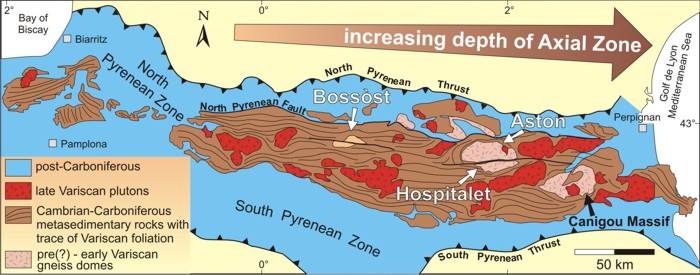
|
| Overview map showing the main tectonic elements of the Axial zone of the Pyrenees. Areas affected by Alpine deformation are shown in blue. Note the increasing exposure of the Variscan basement towards the east. |
In the Bossòst dome, also known as the Garonne dome, along the French and Spanish border amphibolite facies mica schists preserve metastable assemblages that indicate polymetamorphism. Early medium pressure - medium temperature regional metamorphism is succeeded by low pressure - high temperature metamorphism related to granodiorite intrusion. The two different metamorphic events are separated by strong ductile deformation in a crustal scale shear zone (see figure below). Metastable mineral assemblages (staurolite-cordierite) are preserved due to favourable whole rock chemistry. The shear zone was active during emplacement of the Bossòst granite and resulted in local ESE-WNW directed extension. Studies of the Bossòst dome are finished and published in Geological Magazine (2003, v.140-5, abstract) and Comptes Rendues de Geoscience abstract.
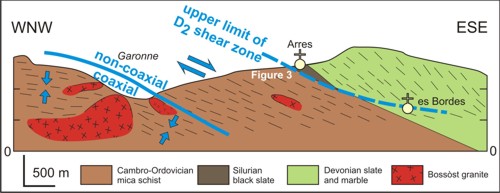
|
| Model of the Bossòst shear zone along the Garonne valley, also known as the Val d'Aran, in the southern antiform of the Bossòst dome pair. Non-coaxial deformation is recorded in an extensional shear zone in the roof of the ascending granite. Coaxial deformation prevailed in the developing contact aureole, partially overprinting earlier triclinic fabrics. Modified after Mezger & Passchier (2003). |
The Aston (north) and Hospitalet (south) massifs are separated by the Mérens fault and shear zones. The massifs are cored by extensive orthogneisses of various composition. The orthogneiss bodies are penetratively deformed and their foliation has similar orientation as the schistosity of the mantling Cambro-Ordovician schists. The Hospitalet orthogneiss is characterized by pervasive ductile deformation indicating top-to-the-east shearing, while in the Aston orthogneiss non-coaxial shearing is only observed at its the eastern termination. This may be caused by the exposed deeper roots of the Aston orthogneiss, which has not experienced shearing, while the higher structural levels within the Hospitalet orthogneiss were prone to shearing. This hypothesis is outlined in the 3-D model in the figure below.
The metamorphic mantling rocks show higher metamorphism in the western Aston-Hospitalet (up to upper amphibolite facies and migmatisation) than at the eastern part, where peak metamorphism is recorded in cordierite-andalusite schists. Early non-coaxial NW-SE-directed deformation is preserved in the high-grade schists in the Soulcem area in the western Aston dome. Preliminary results are published in the online Journal of the Virtual Explorer (2005, Volume 19, Paper 6. (abstract) (View article on JVE website.)
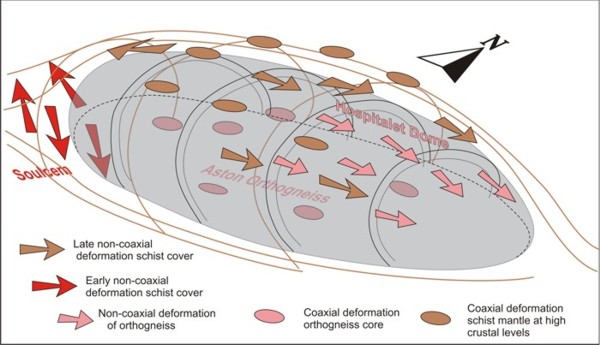
|
| Simplified dome model of the Aston and Hospitalet massifs showing the postulated differing deformation patterns due to strain partitioning prior to activity of the Mérens fault or shear zone. |
The current state of research can be summarized:
These results will be published in a special volume of the Bulletin de la Société Géologique de France very soon (late 2008 or early 2009).
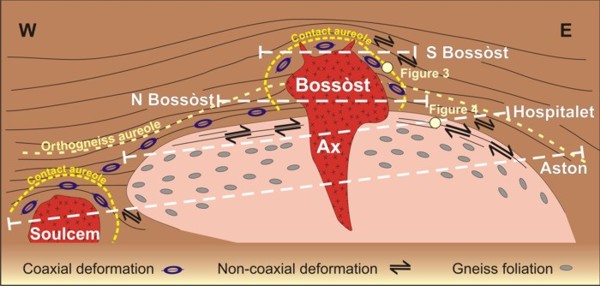
|
| Orogen-parallel cross-section through an idealized gneiss dome with the present day erosional levels of the two dome pairs. Model is not to scale. The westward tilting of the Hospitalet and Aston domes is speculative and based on the presence of higher pressure metamorphic phases (staurolite) in the western sections. Modified from Mezger (in press, Bulletin de la Société Géologique de France). |
Ongoing research and future tasks:
Cees Passchier introduced me to the Pyrenees when I started my postdoc in Mainz in 1998. Jordi Carreras and Elena Druguet of the MIET laboratory of the Universitat Autònoma de Barcelona introduced me to the fabulous structures of the eastern Pyrenees were involved in many fruitful discussions. With Yoann Denèle, a former PhD student at the Université Paul Sabatier, Toulouse, I enjoyed several interesting field trips to various parts of the Aston dome. Jean-Luc Régnier, former PhD student at the Johannes Gutenberg University in Mainz, put in a lot of effort to produce pseudosections of schist samples from the Bossòst dome using ThermoCalc. Finally, two diploma students, Christopher Roelke and Stephan Schnapperelle, did an excellent job in mapping the Mérens fault and shear zone in the summer of 2008.
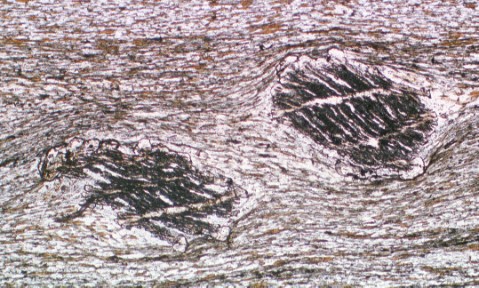
This project led to a PhD in Geology at the University of Alberta, Edmonton, Alberta, Canada, in 1997.
Research focussed on a large belt of metamorphic rocks, the Kluane metamorphic assemblage (KMA), predominantly metapelitic rocks and some minor ultramafic rocks, wedged between pericratonic assemblages (Yukon-Tanana terrane) along the ancestral North American continental margin and accreted volcanic island arcs (Alexander terrane).
During my stay at the University of Alberta I enjoyed the supervision of Philippe Erdmer (main supervisor and structural geology), Tom Chacko (all matters metamorphic) and Rob Creaser (isotope geology).
Results from this project led to a PhD thesis at the University of Alberta in 1997, and subsequent publications in the Journal of Metamorphic Geology (vol. 19, 2001), Canadian Journal of Earth Sciences (vol. 38, 2001), Yukon Exploration Geology 1999 and 2002.
For a complete list of publication, visit my publications page.